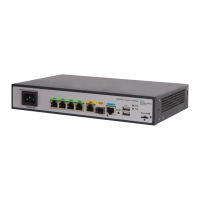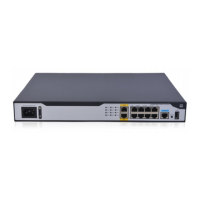8
-f first-ttl: Specifies the TTL of the first packet sent to the destination. The value range is 1 to 255, and
the default is 1. It must be no greater than the value of the max-ttl argument.
-m max-ttl: Specifies the maximum number of hops allowed for a probe packet. The value range is 1
to 255, and the default is 30. It must be no smaller than the value of the first-ttl argument.
-p port: Specifies an invalid UDP port of the destination. The value range is 1 to 65535, and the
default is 33434. If the destination address is an EID address at a remote LISP site, specify a port
number in the range of 33434 to 65535.
-q packet-number: Specifies the number of probe packets to send per hop. The value range is 1 to
65535, and the default is 3.
-t tos: Specifies the ToS value of probe packets. The value range is 0 to 255, and the default is 0.
-topology topo-name: Specifies the topology to which the destination belongs, where topo-name is
a case-sensitive string of 1 to 31 characters. If the destination is on the public network, do not specify
this option.
-vpn-instance vpn-instance-name: Specifies the MPLS L3VPN instance to which the destination
belongs, where the vpn-instance-name argument is a case-sensitive string of 1 to 31 characters. If
the destination is on the public network, do not specify this option.
-resolve-as: Specifies a routing table for autonomous system (AS) resolution. Tracert searches the
specified routing table for the AS that each hop along the path belongs to. If you do not specify this
keyword, the global routing table is used. If the AS information is found, this command displays the
AS number next to the address of the hop in the probe result.
global: Specifies the global routing table.
none: Disables AS resolution.
vpn: Specifies the VPN routing table.
-w timeout: Specifies the timeout time in milliseconds of the reply packet for a probe packet. The
value range is 1 to 65535, and the default is 5000.
host: Specifies the IP address or host name of the destination. The host name is a case-insensitive
string of 1 to 253 characters. It can contain letters, digits, and special characters such as hyphen (-),
underscore (_), and dot (.).
Usage guidelines
After identifying network failure with the ping command, use the tracert command to locate failed
nodes.
If the destination address is on the public network, you do not need to specify the -resolve-as
keyword to obtain the AS information. The device automatically uses the global routing table for AS
resolution.
If the destination address is on a private network, address information of intermediate hops might be
stored in either the global routing table or the VPN routing table. To learn the AS path that the
packets traverse, execute the tracert command twice, once with the -resolve-as global keywords
and again with the -resolve-as vpn keywords.
The output from the tracert command includes IP addresses of all the Layer 3 devices that the
packets traverse from source to destination. Asterisks (* * *) are displayed if the device cannot reply
with an ICMP error message. The reason might be the destination is unreachable or sending ICMP
timeout/destination unreachable packets is disabled.
To abort the tracert operation during the execution of the command, press Ctrl+C.
Examples
# Display the path that the packets traverse from source to destination (1.1.2.2).
<Sysname> tracert 1.1.2.2
traceroute to 1.1.2.2 (1.1.2.2), 30 hops at most, 40 bytes each packet, press CTRL_C to
break

